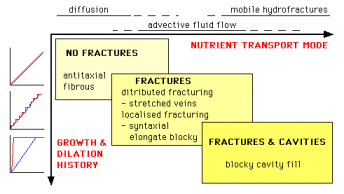Veins can have a range of microscopic morphologies. Even a single vein
can have different textures, such as polytextured blocky + fibrous veins
(Fig. 14). There is not a clear one-to-one relationship between macroscopic
and microscopic morphology. Fibrous crystals can be found in pressure fringes,
lenticular veins and fracture-shaped veins. It is therefore not easy to
make a simple link between morphology and conditions and processes of vein
growth. Also, the processes that lead to vein formation are not sharply
delineated. For instance, during seismic pumping, a single growing vein
may experience periods of advective fluid flow between periods of dominantly
diffusional nutrient transport. Such a variation in process can also occur
in space: while at one spot fluid may flow through a fracture and deposit
vein material, another fracture nearby may be dead-ended and not experiencing
fluid flow, but only vein growth by diffusional nutrient transport. Despite
this, an attempt can be made to correlate processes and vein morphology
as much as possible (Fig. 30).
As was discussed in this paper, fibrous veins may form without fracturing. This implies that nutrient transport is either by diffusional or by pervasive porous flow transport. Considering that pressure fringes are usually fibrous and are in their shape controlled by the local stress distribution, diffusion is the most probable nutrient transport mechanism for pressure fringes and therefore for fibrous vein growth. In case of pyrite-type (antitaxial) pressure fringes, the site of lowest pressure is at the surface of the object, which is the growth plane. In case of crinoid-type pressure fringes and solid relatively rigid veins, the lowest pressure lies on the outside of the fringe or vein, which is indeed the growth plane (antitaxial veins). In fracture-less growth, the rate of vein growth is at all times exactly the same as the dilation rate, which is the rate at which the wall rock on either side of the vein moves apart.
An important class of veins is formed by those veins that formed by repeated crack-sealing. In that case, the dilation rate is spiky, with the vein growth rate passively following to fill any dilation. Elongate blocky textures form when the growth plane remains a plane of weakness (localised fracturing), possibly due to imperfect sealing. Such veins are in principle syntaxial. If fracturing occurs at different sites in a vein throughout the dilation history (distributed fracturing), and thus cuts through previously grown vein material, stretched veins form. Both elongate blocky and stretched crystals form in the absence of ongoing nucleation, which precludes large supersaturation in the vein forming fluid. The nutrient transport mechanism can be diffusion and/or advective flow.
An interesting question is whether crack-sealing and fractureless vein formation are end members of a continuous spectrum or distinct processes. Macroscopic fractures and grain boundaries are distinctly different, but microcracks and wide grain boundaries as described by Drury & Urai (1990) may provide the link between the two end members. This question remains open.
Sudden extensive dilation leads to the formation of large cavities. Such cavities can only form at depth by excessive fluid pressures, which can arise from seismic pumping / fault-valve like processes or by the arrival and arrest of batches of fluid from rising mobile hydrofractures. Large cavity-fill veins usually have a blocky texture, indicating large supersaturation. Extremely large supersaturations can occur in fluids that very rapidly rose through the crust in mobile hydrofractures. The veins that formed from such fluids indicate arrest and sudden chemical equilibration of these fluids, not their passage.
In recent years, much emphasis has been put on crack-sealing and advective fluid flow. Although these processes are undoubtedly very important for the formation of veins, other processes should not be neglected. Fibrous veins and pressure fringes that formed by fracture-less vein growth are important for strain analysis, while mobile hydrofractures provide a mechanism to rapidly transport vein forming minerals (particularly quartz) and, more importantly, ore minerals such as gold, up through the crust.
